#lloth
Text
Sharess was originally a good aspect of Shar *and* Lolth?
...and perhaps the fragment of remaining goodness from both evil goddesses, with all three being possibly originally the same entity? (At least in late 1st and early 2nd edition AD&D lore)
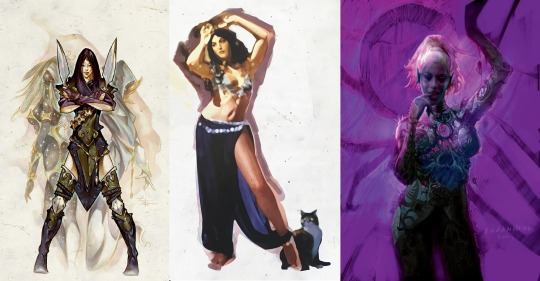
Depictions (from left to right) of Shar, Sharess and Lolth, from 2003's Faiths and Pantheons
It might be a bit obscure, but rather than Bast merging with/absorbing the goddesses Felidae and Zandilar the Dancer; Sharess was originally intended to be a Chaotic Good aspect of Shar, as seen in her very first description in the original 1987 "Forgotten Realms Campaign Setting":
"Sharess, a CG aspect of Shar worshipped
in Calimshan, Waterdeep,
and by idle rich or decadents all
over the Realms. Sharess is a goddess
of lust, free love, and sensual
fulfillment, and is worshipped in
prolonged fests with scented
baths, music, good food, dancing,
and other gratifications."
This when asking one of the writers/editors, Matt Sernett about this, he confirmed that Sharess was actually meant to be a benevolent aspect of Shar, and this not being a misdirection as presented later in lore.
This was basically repeated in 1988's "Empires of the Sands", as well as in the 1993 2nd edition Forgotten Realms Campaign Setting, though the latter further suggesting Sharess' benevolent nature might be an act, or that Sharess became a separate being from Shar by this point:
"The true nature and identity of Sharess is unrevealed. She may he
a direct part of the evil Shar, preparing her following for despair and
loss. Or she may be a new thing entirely: a goddess of excess."
This starts to become even more interesting with 1991's "Drow of the Underdark", in the section with the short dictionary of Drow language. There "valsharess" is explained as meaning "Queen", and "Quarvalsharess" "(the) Goddess" in Drow language, specifically and only meaning Lolth (other goddesses are are written as quar'valsharess, and not starting with a capital letter).
The same sourcebook, details the syncretic She-Spider cult - who seemingly consider Lolth and Shar to be the same goddess. The cult was opposed by both goddesses, which is curious, seeing Shar's eagerness to subsume other deities. Though Lolth did latter possibly send her priestess (Malabeth Tr'rudena) to infiltrate the cult.
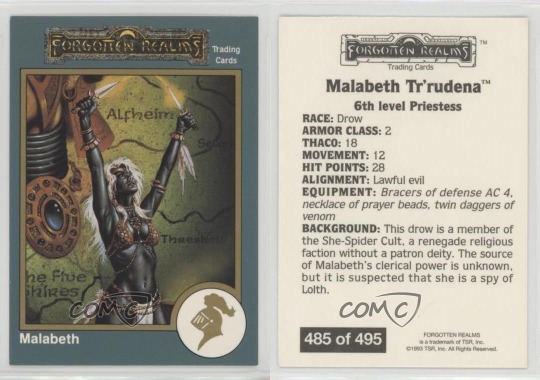
A card from TSR's Advanced Dungeons & Dragons Trading Cards, depicting Malabeth.
This is a proof (along with the mention Shar worship is relatively popular among Drow), of such syncretic cults between the two goddesses existing, as well as one of the hints Shar and Lolth are or were to a degree aspects of each other. Similarly how Sehanine Moonbow in both 2nd edition and 4th edition, was stated to be aspect of Shar's sister, Selûne, most notably first in the above mentioned 2nd edition Forgotten Realms Campaign Setting:
"Sehanine: Sehanine is an intermediate power among the elves of
the Realms, for they refer to her as an elven version of Selûne, the mortal goddess of the moon."
Indeed, Sharess herself might had been a hint at the connection between Lolth and Shar.
There appeared more hints overtime, like similar antagonism between the 2 pairs, Shar and Lolth becoming both connected to the New Moon, and even more in late 3.5 edition and 4th edition/Nerath lore.
For example, it was stated at the very end of 3.5th edition that the god Mask is Shar's son, mirroring Vhaeraun being the son of Lolth. The two gods are very similar, both being gods of thievery connected to shadows, as well as Vhaeraun being called the "Masked Lord", "Masked Mage", "Masked God of the Night". Furthermore, both gods share near identical titles - Vhaeraun being called the "Lord of Shadow" and "Shadow Lord"; Mask being known as the "Lord of Shadows" and "Shadowlord". Both having a similar to near identical symbols. With there being theories, and hints before this reveal, Mask and Vhaeraun might be connected, maybe even aspects of each other, Mask even kinda hinting in one novel (1998's "Crucible: The Trial of Cyric the Mad" by Troy Denning) he is the same as Vhaeraun.

Symbols of Vhaeraun (left, from 1998's "Demihuman Deities") and Mask (right, from 1996's "Faiths and Avatars")

Pictures of Vhaeraun battling his son, Selvetarm (left, from 2004's "Player's Guide to Faerun"), and of Mask (right, from 2003's "Faiths and Pantheons")
On Nerath, in turn Lolth and Sehanine are described as sisters, like Shar and Selûne are. So the (at least initial) opposition to the She-Spider cult from both, being possibly from not wanting for their connection to be revealed; or alternately be merged back by the power of belief.
Though to be clear, this could work either way if Shar and Lolth are or were aspects of each other, or not. As Sharess, in her original lore, possibly sprung into existence from the worship of the syncreticism of Shar and Lolth, that arose among drow, and then spread to other races/species, possibly originally named "Quarvalsharess"; before the name became shortened/corrupted among non-drow into just "Sharess". Or even started out named already Sharess among even drow, shortening from Quarvalsharess, to emphasize the "Shar" part.
It's probable Shar at least had more control over the Sharess aspect than Lolth (seeing Sharess was directly stated to be connected to her), and possibly the new goddess, in part absorbing or mirroring whatever benevolent aspects the two goddesses had, became an independent being. This quite probably being at least in part also caused by "Time of Troubles", when gods were forced into singular avatars, this event would have cut-off Sharess from both Shar and Lolth. Especially seeing the possibility of Sharess being an independent entity, was first mentioned not long after the Time of Troubles (ie when 2nd edition Forgotten Realms setting was set).
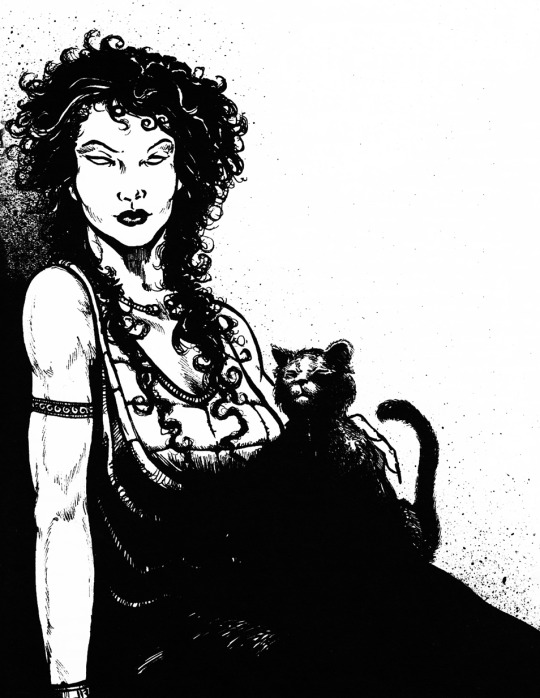
Depiction of Sharess, from 1995's Polyhedron #109
Soon though, Sharess was given a different origin (first in 1995's “Forgotten Deities: Sharess” in Polyhedron #109, then further developed with some changes in 1997's "Powers and Pantheons" and 1998's "Demihuman Deities") , if still being connected to Shar, and (more indirectly) to drow, and being an amalgamation of aspects of multiple goddesses (but different ones); it's still though an interesting possibility/alternate origin for home campaigns.
Or perhaps even theorizing some part of Shar or even Lolth did get into the divine merger that was Sharess.
("Was", as in 5th edition lore, Sharess was basically split back into Bast and Zandilar).
46 notes
·
View notes
Text
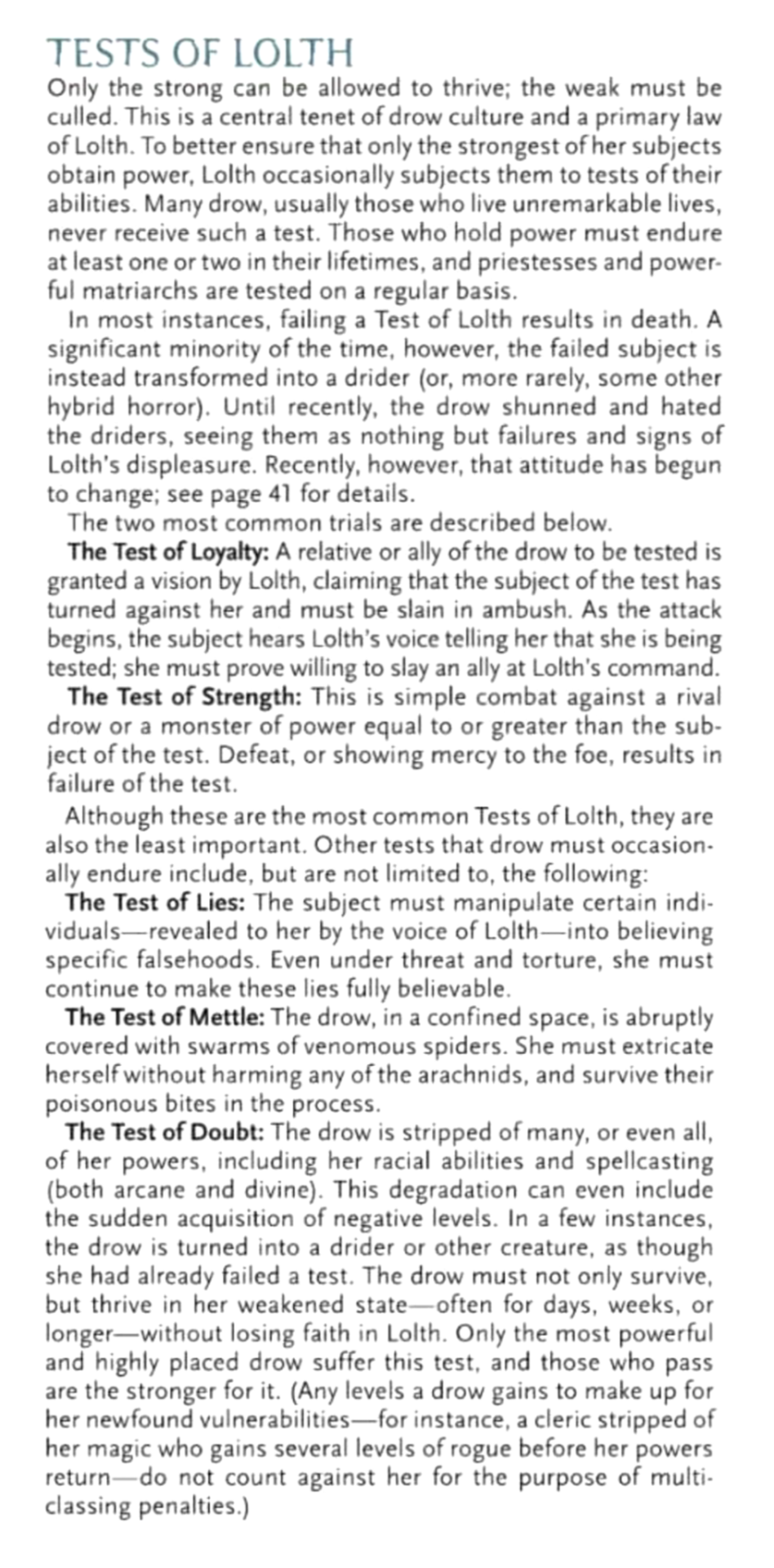
#dnd drow#Menzoberranzan#lolth#lolth the spider queen#lloth#lloth the spider queen#lolth tests#lloth tests#drow elves#drow elf#drow
16 notes
·
View notes
Text
Finally painted and assembled this baby !!!
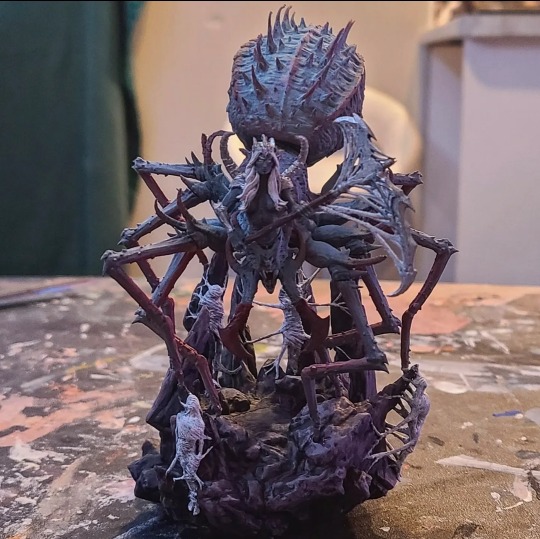
#drow#dnd#dnd drow#drow elf#drider#Lolth#Lloth#Lolth the spider queen#Lloth the spider queen#dnd figure#dnd mini#dungeons and dragons
105 notes
·
View notes
Text
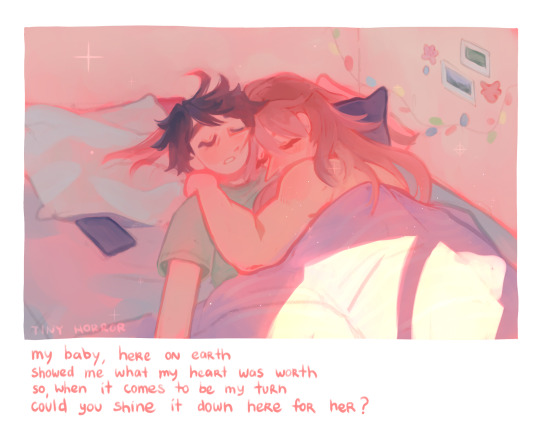
lazy morning ✨☀️
insta | twitter | inprnt | redbubble
#my art#clip studio paint#csp#digital art#digital artist#small artist#own art#original art#oc#lloth#???#mort oc#animation#animated gif#pink art#sunshine#pink aesthetic#wlw#sapphic art#sapphic#sapphic artist#sapphic oc#wlw drawing#wlw oc#wlw art#wlw positivity#wlw love#wlw post#sapphic love#sapphic positivity
17 notes
·
View notes
Text

X
13 notes
·
View notes
Text
What would a Matriarchal society look like?
Article by @worldanvil.
We've seen R.A.Salvatore write Lloth's Menzoberranzan in the Drizzt novels, and then there's the Barbie movie...
#Matriarchal#Matriarchy#World Anvil#Society#Lloth#Menzoberranzan#Drizzt#Barbie#DnD#D&D#Dungeons and Dragons#Fantasy#TTRPG#Tabletop#RPG#Roleplaying Game
11 notes
·
View notes
Text
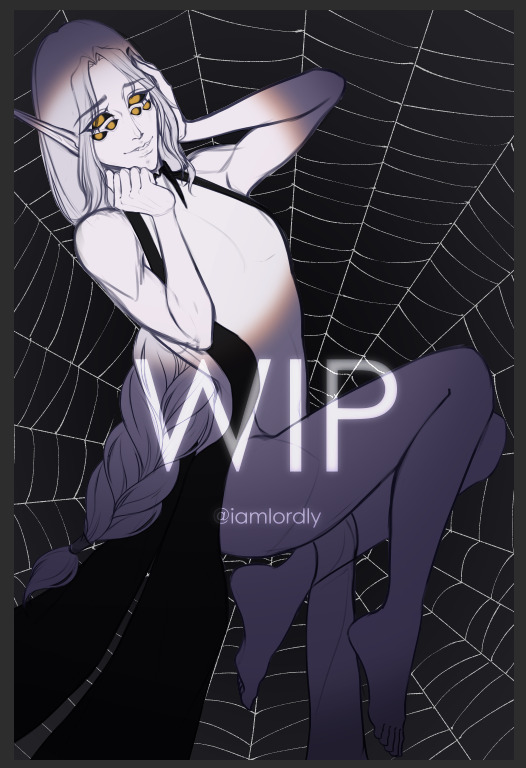
Isiah, Child of Lloth
New spider babey I'll be playing soon, they are very sweet and only wants a little nibble.
I'm also thinking of turning this comp into a YCH
#my art#goth#aasimar#elf#lloth#commissions open#wip#sketch#drow#dnd art#dnd character#dnd bard#dnd oc#dnd5e#dnd#my twink#spider#multiple eyes#tw eyes
10 notes
·
View notes
Text
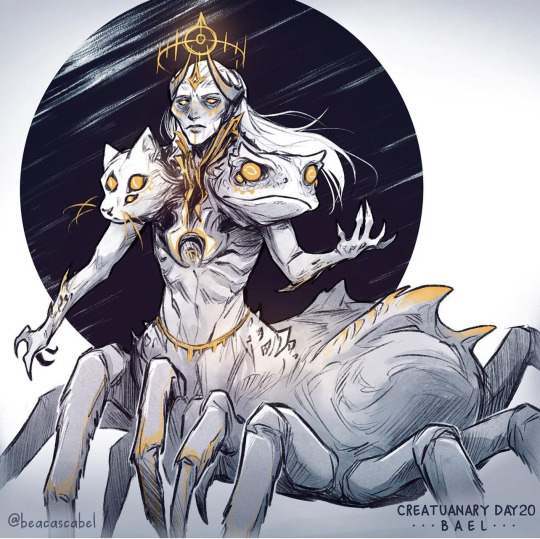
Hell is for the Fallen, no mere mortals shall taste it’s darkness or feel it’s flame ❤️🔥🩸🖤
https://instagram.com/beacascabel?igshid=NDk5N2NlZjQ=
instagram
#demonology#devil aesthetic#devils#hell#fantasy#digital art#digital painting#ig artist#ig art#fantasy art#demon art#demon boi#demon king#art challenge#circles of hell#dnd#monster art#spider aesthetic#spider demon#lloth#spider god#dnd gods#Instagram
14 notes
·
View notes
Text
T'puuli d'Aron Khalith
This is one is another concept that I’ve had for a long time in the back of my mind, and occasionally in the front. He’s been the “backup” character in at least two campaigns where it ended up just not happening. He’d need some work to not be insufferable long term.
Paladin (Oathbreaker)/Sorcerer (Shadow Magic)- Acolyte - Drow - Chaotic/Good
Languages (Elvish/Common due to Race. Abyssal/Celestial from Acolyte. Undercommon from Drow?) -
Backstory Concept: A Male Drow and follower of Lloth, but insists on referring to her by her pre-fall name, Araushnee. Additionally insists that the legend of how Araushnee fell is a lie, propaganda spread by the other elven gods and their followers, who are in fact conspiring against her and always have been. Believes he has been personally saved by Araushnee, and insists that it was neither a dream nor a delusion brought on by severe blood loss. Often speaks ill of Eilistraee, the Dark Maiden and daughter of Araushnee, claiming the Dark Maiden's virtues are all a façade to steal attention away from her mother. He departed from the bulk of Drow society because of all the "fake" followers of Araushnee. Despite the difference in the specifics of his views, he is not viewed as a heretic by the Lolthites, but an eccentric. Accepted, but best avoided, the zeal with which he shows his devotion to the Spider Queen serving to compensate for his quirks. Shown a degree of disdain as "that guy". Takes almost everything relating to Spiders as some sort of sign from Araushnee.
Misc:
- Araush-nee-san~
- His Summon Steed is a pure white Steeder he calls Lodtyna
Appearance: 5′11, 145 lbs. Yellow eyes, white hair. Hair is long and free flowing. His eyebrows are perfectly groomed, and quirk just so. His jaw is chiseled. Just incredibly handsome right up until he opens his mouth. Wears gleaming white armor the symbol of Lloth displayed clearly upon his tabard. Uses a sword and shield.
#dnd#D&D#Dungeons and Dragons#Character Concept#Personal#White Knight#That Guy#Lloth#Araushnee#Drow#dnd Paladin#Oathbreaker Paladin#Glory Paladin#Maybe#Steeder#Lodtyna#T'puuli d'Aron Khalith#Eilistraee#Probably a terrible idea
2 notes
·
View notes
Video
My DnD characters <3 for more nerdy content, follow me
#dnd#dndaddies#dndgay#drow#halfelf#diamanda#araxie#pathfinder#ttrpg#ttrpg oc#oc#furryoc#fursona#lion#necromancer#druid#priest#lloth#sorcerrer#dnd sorcerer#fantasy#gay#lgbt#viking#volva#fighter#dndcharacters#witcher#roleplay
4 notes
·
View notes
Text
D&D Demon Lords and Warhammer Chaos Gods - Lolth and Slaanesh
(trigger warning: mature themes and topics)
Another, perhaps less obvious similarity is between Lolth and Slaanesh, and how Lolth possibly in part inspired the Prince of Pleasure (and even maybe got some inspiration in return).
Lolth, in her first appearance in 1978's "D3 Vault of the Drow" module, was hinted to have a connection to excess, including debauchery but also excessive ambitions. In the same module, drow society in the city state of described as:
"The main ways of this ancient and depraved city are
thronged with as unlikely a mixture of creatures as can be
imagined. Green cloaked Illithids and Kuo-Toans rub
shoulders with Dark Elves. Ghosts and ghouls roam freely, and
an occasional shadow or vampire will be seen. Bugbears
and troglodytes are common, as are other various servants
and slaves of the Drow (dwarves, goblins, half-orcs, humans,
and orcs are sometimes free inhabitants of the place). All are
pale from dwelling in the sunless Vault. Trolls slink by evillooking
men wearing the green garb. None are disturbed to
pass a lesser demon or succubus, a night hag or mezzodaemon.
These crowds part hurriedly for Noble Drow riding
nightmares or the more powerful demons or nycadaemons
(see special section at the end), but those of the Dark Elves
with pack lizards must slowly force their way through traffic.
Beggars of all sorts are seen, and half-Drow thieves, pimps,
and harlots are as common as the enslaved human and
elven prostitutes displayed before certain establishments."
"The tiers and dungeons of Erelhei-Cinlu reek of debauchery and decadence, and the city's inhabitants are degenerate and effete.
(Those with any promise and ability are brought out of the
place to serve the fighting societies, merchant clans or noble
houses. The rest are left to wallow in the sinkhole of absolute
depravity which is Erelhei-Cinlu.) The most popular places in
the city are the gambling dens, bordellos, taverns, drug
saloons, and even less savory shops along the two main
streets. The back streets and alleyways too boast of brothels,
poison shops, bars, and torture parlors. Unspeakable things
transpire where the evil and jaded creatures seek pleasure,
pain, excitement, or arcane knowledge, and sometimes
these seekers find they are victims."
Succubi are also noted to be most probable to appear out of fiends in the city streets, even one Silussa, having an role along with her lover, the drow vampire Belgos. As detailed in the sequel module, "Queen of the Demonweb Pits", succubi are specifically mentioned among Lolth's servants in the Palace of Lolth.
While the city's decadence and debauchery aren't directly stated as connected to the worship of Lolth, it is suggested to be the case, especially in how the temple of Lolth is described as having:
"An obscene tapestry at the rear of the temple screens a pair of
double doors which lead to the lower level of the place."
"2) The bed chamber of the High Priestess is as lewdly and
evilly decorated as the outer room. There are no spider
tapestries here, merely opulent furnishings, including
various jeweled objects of great value (13 items with a
worth of 1,000-8,000 g.p each)—including a strange
platinum rune set with black opals (if it is touched a
nycadaemon is summoned, and it will expect something
altogether different than the party of adventurers,
so it will immediately attack!).
3) Behind the secret door is a cell wherein is chained an
insane human of great strength (9th level fighter; H.P.: 73;
18/81 strength, 11 intelligence, 9 wisdom, 16 dexterity, 18
constitution; 17 charisma) kept here by Charinida for
whatever purposes please her at the time. There are
several whips and torture instruments on one wall, and
near them is a gag and a ring of invisibility. Note that the
prisoner is bound to the east wall where the secret
entrance to room 4) is."
Lolth's (probable) depiction on the cover (by Keith Parkinson) of the 1986 compilation of the Giants, Drow modules, the supermodule Queen of the Spiders, might had inspired John Blanche's depiction of Slaanesh in 1988's "Realms of Chaos: Slaves to Darkness":


The positions of the two are even very similar, if mirrored

Slaanesh is also described to look (to mortals) as golden haired, and in combination with this picture, fair-skinned, which seems less similar to Lolth...except how she appeared in the 3rd episode of the 1983 Dungeons and Dragons cartoon "The Hall of Bones", were she appeared exactly with those physical traits, in her human or elven form:


Along with the succubi, it's also worth mentioning Lolth is probably named and based in part on Lilith. Especially that the Hebrew form of the name Lilith, discovered in the Dead Sea Scrolls, was Liloth, Liliyyot or Liliyyoth.
Lolth's name is also curiously influential here. It's notable it was often misspelled by players and fans as "Lloth" since her debut, this even finding it's way to official sourcebooks and novels set in Forgotten Realms (first in the 1988 novel "The Crystal Shard" by R.A. Salvatore, but especially in 2nd edition (1989-2000)).
It was in the same edition, clarified as an alternate spelling, mostly used in the city states of Menzoberanzan and Uluitur (and often on the suffrace above them).
But in the first edition, and original 1986 Warhammer Fantasy Roleplay sourcebook (and it's reprints), we are introduced to a mysterious divinity of hedonism worshipped once by elves, Meneloth:
"•THE DEVELOPMENT OF THE ELVES•
Largely untouched by the collapse of the interdimensional
gateways, the Elves in their island Kingdoms continued to prosper.
Their already considerable knowledge of Old Slann magic
allowed them to control and direct many of the new entities.
From amongst these beings, the Elves chose several benign
creatures and cultivated their worship, including the hedonistic
creature they call Meneloth."
Meneloth was for years thought to be somehow connected to Slaanesh, either as an alias or a Daemon Prince or Greater Daemon serving them, something this passage vaguely implies seeing Meneloth's connection to Chaos, elves and hedonism.
The only "semi-official" confirmation of Meneloth's identity, is from a 2004 pulication for a French Warhammer Fanzine "le Grimoire" "Warhammer : Chaos - Les Terres Du Nord" (but one on which worked official Warhammer writers/creators: Alfred Nuñez Jr. and Anthony Ragan. As well as Stephan Foulc, but he only worked on official Warhammer stuff after this books publication):

Or Google Translated:
"Slaanesh is the Prince of Chaos, the Power of Chaos dedicated to the pursuit of hedonistic pleasures. He is the Master of Pleasures, lord of excess. He reigns in a vast palace lavishly arranged in the void, where his favored servants cover the ground indulging in all perverse forms of carnal pleasure before his divinely graceful and ravishing eyes. He is represented by the peoples of the North in the form of an oversized albino serpent named Loesh. He is also worshiped by the elves as Meneloth."
Here is also mentioned the name of Slaanesh- "Loesh", also connected to a related alias, "Loeth", both similar to the "Lloth" spelling of Lolth's name. Or even more so to another spelling mentioned in 1991's "Drow of the Underdark, "Loethe".
In her appearances in D3 Vault of the Drow, 1980 Q1 Queen of the Demonweb Pits, 1980 Deities and Demigods and 1981 Fiendish Folio, Lolth was described as having 66 hitpoints (though it might had been meant 166 after D3 (as Gary Gygax described the appearance of Lolth there later as an "avatar), but 1 was lost in latter publications). Still, note that later Slaanesh' number was noted to be 6.
Also, in 1987's Manual of Planes, Lolth's realm is in on both on the 65th and 66th layers of the Abyss (and she is ultimately more associated with the 66th layer).

A very early depiction of a Warhammer female dark elf - "Forces of Fantasy" 1984. Note what seems like pitch black skin (like of a drow from D&D), and the the large spider symbol, akin to symbols of Lolth drow wear in D&D. It's notable in very early Warhammer lore, before 4th edition (1992), dark elves worshiped the Chaos Gods (with Khaine and Khorne being seen respectively as the elven and human names/aspects of the Blood God - as described in 1988 White Dwarf #108), especially Slaanesh. This artwork was also basis for the figurine described officially as the "Witch-Queen of Dark Elves", a seemingly a very early version of Morathi
Lolth, as stated above, is worshiped and closely connected to drow/dark elves, being their main deity. She was also described in some sources as worshiped also by other "depraved elves", something she desires somewhat secretly from her drow worshipers, to expand (along with worship among humans, which is also present).

Lolth, in her demonic form, "Q1 Queen of the Demonweb Pits", 1980. Also used in 1991 "Drow of the Underdark"
Her connection to elves, was first expanded in the original, 1980 "Deities & Demigods" sourcebook, were she was, in a legend described there, involved in the very creation of elves, as well indication she started out as something other, and fallen into demonhood, when describing the chief deity of the elves, Corellon Larethian:
"The god is also mighty in battle, and is said to have personally banished such demons as Lolth from the sunlit Upperworld. Elven lore states that the race of elves sprang from the drops of blood Corellon shed in this epic battle."
It implying Lolth has a connection to darker side of the elves, due to having a hand in their creation. And indeed, multiple instances of the drow origin, states Lolth sowed corruption in elven hearts, causing the origin of the dark elves (or alternately, corruption/fall of dark elves into drow elves).
(Latter descriptions of this legend, have Corellon Larethian's blood being spilt in his battle with the king of the orcish gods (and his brother) Gruumsh, and from this blood (and mixed with the tears of the moon goddess, Sehanine Moonbow), rose elves, while from blood of Gruumsh spilled by Corellon, orcs. Though even other versions, describe elves and orcs existing even before this event.)
Lolth's archenemy, Corellon Larethian, might also be an inspiration for Slaanesh, seeing as far as the very same 1980 Deities & Demigods book, he is described:
"Corellon Larethian represents the highest ideals of elvenkind: "he" is
skilled in all the arts and crafts, and is the patron of music, poetry, and magic. Corellon is alternately male or female, both or neither."
Corellon is a highly benevolent figure compared to Slaanesh (described as Chaotic Good), if not without a darker side described in some later lore (2nd edition and latter).
Like Lolth is seemingly inspired by Lilith, Corellon Larethian appears to be inspired in part by Adam - both the physical Adam, as ancestor of humanity (and who, in some Jewish writings, is described as a hermaphrodite before the creation of Eve from his rib; the rib, due to it's ambiguous meaning in Hebrew, probably originally meant "other side" or "other half"); and the divine model and oversoul of humanity (and manifestation of the Abrahamic God to a degree), Adam Kadmon, also described as a hempahrodite. Adam Kadmon is not a Biblical figure, but from Jewish (originally), as well as Christian and Gnostic mysticism.
His name might be in part derived from an alternate name of Adam Kadmon - Adam Elyon. Corellon - Cor Ellon - Cor Elyon (Elyon is also one of God's names).
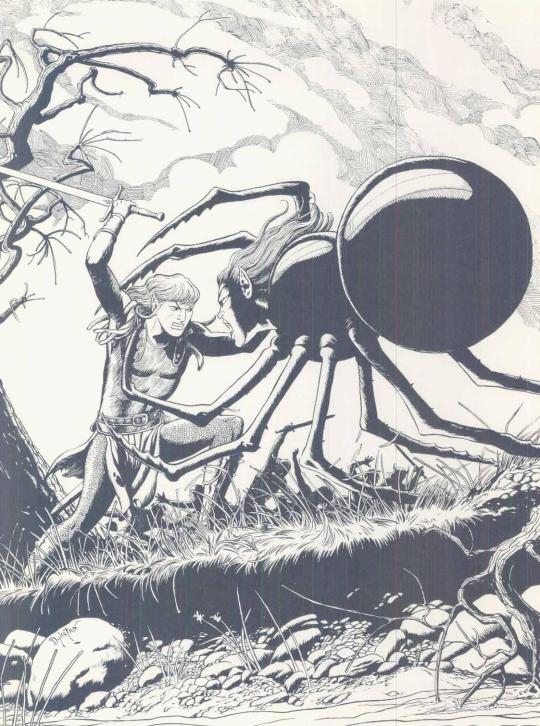
The battle of Corellon Larethian and Lolth. The Complete Book of Elves, 1993
Other elven gods though - the pantheon being called "Seldarine" - are also described as malleable in terms of sex and gender - first in 1980s Dragon #62 (their proper debut) 2 elven deities were described as such - Labelas Enoreth (god of longlivety, time and history) and Hanali Celanil (goddess of love, romance, beauty, fine art, artisans and artists), and in 1992's "Monster Mythology" all of the Seldarine were described as having malleable sex and gender (if there is one their appear/are represented more often as).
Lolth was described in 2nd edition as a fallen member of the Seldarine in 1994's "Planes of Chaos" (if being, arguably, implied being such since 1980 Deities & Demigods). So despite her misandry, sharing the sex and gender malleable nature of the Seldarine. Though so do demons in general, as I wrote in my post about Graz'zt and Slaanesh, and it's notable as I mentioned in my other post, Lolth's was not always portrayed as a misandrist, and some modern publications do imply her misandry is at least partially "performative".
As expanded in 1998's "Demihuman Deities", and even more in the same year's novel "Evermeet: Island of Elves" by Elaine Cunningham, Lolth was originally Araushnee, the lesser elven goddess of destiny and artisans, and wife and lover of Corellon Larethian (adding a further layer to their status as each others nemesis), that was cast out and transformed into a demon after an attempted murderous coup, and several other attempts at Corellon's life, and attempts to replace him. The artisan part of her portfolio was curiously taken over by the mentioned above Hanali Celanil.

4th edition depiction of Corellon's and Lolth's battle. Dragon #394, 2010
As I mentioned above, Lolth, despite sexuality, lust, desire decadence or debauchery usually not being described as part of her divine portfolio, Lolth is described as beings deeply connected to lusts and desires, as well excess. In 2nd editions 1991's "Drow of the Underdark" (this and other details, repeated in "Demihuman Deities"), Lolth's avatar was described as basically having a seduction attack, like a succubus (or akin to Slaanesh supernatural charm that seduce anyone), and some other interesting details, like being implied to be amorous to a degree towards mortals, regardless of gender:
"Even more, Lolth enjoys corrupting elves and humans to her service. In drow form, her direct physical embrace can act as a charm person (save at -4) on a human or demi-human of either sex. She customarily leaves a poisonous spider to aid, guard, and keep watch on those who personally serve her, and gives them any one magical item that she possesses or one magical item that she possesses or can seize. Lolth can appear kind, rendering aid to those she fancies but she really cares only for herself; her favor and aid can never be relied on."
"She enjoys the company of spiders of all sorts; when in drow form, she often clothes herself entirely in clinging spiders."

Lolth, clothed only in spiders, webs and her crown, surrounded by most members of the Dark Seldarine. "Demihuman Deities", 1998
Demihuman Deities also gives, I think for the first time, one of Lolth's titles the "Mother of Lusts".

Lolth's drow form, clothed in what either seems like chitinous armor/clothing, and some spiders crawling on her, or her clothes/armor are are conglomeration and/or merging of various arthropods, including centipedes. "Faiths and Pantheons", 2002
3rd edition also describes Lolth as having access, and giving access to the Lust Domain (along with the Envy, Pride and Wrath Domains) in the 2004 "Seven Deadly Domains" article in Dragon #323 (also stated in 2005's "Spell Compedium").

Lolth's demon form, as described in 3rd edition, murdering curbstomping "fighting" some elves. Note the 6 antennae on her head, as well as having 6 eyes. "Complete Divine", 2004
Lolth is also noted to value incredibly personal ambitions, and courage to do anything to fulfill it. This is why she "forgives" worshipers breaking her rules in pursuit of ambitions (if they aren't caught or get away with it) and even a number of priestesses, that for personal ambition, betray her, and worship her son and enemy, Vhaeraun, if they return to her in pursuit of her ambitions, and even giving them powers during their betrayal, like was with Shakti Hunzrin.
And as was with the mentioned in my Graz'zt post Eclavdra, as described in 2006 "Fiendish Codex I: Hordes of the Abyss" returning to Lolth after betraying her to the worship and service of the Elder Elemental God and Graz'zt (both great enemies of Lolth), explaining to the demon godess she done it in pursuit of her ambition, and recognizing Lolth as the superior master among all of them, was rewarded the position of the highest priestess of Lolth in the whole multiverse, and later (in 4th edition), Lolth even gifted her with a level of divinity.
In general, even Lolth encouraging a level of betrayal among drow (what makes many compare her to Tzeentch), can all be seen as a form of excess (and seeking to fulfill ambitions at all cost), liking her even more to Slaanesh.

A (kinda) more erotic and well, weird version of Lolth (or her avatar) in her demonic form, torturing an elf. "The Book of Vile Darkness", 2002
And in Ravenloft, in the Domain of Dread, Lolth's aspect there, the Spider Queen (as described in 2004's Ravenloft Gazetter V), does have hedonism as part of divine portfolio, and it as a crux of her worshipers dogma among Shadow Elves (pretty much entirely) from the Unseelie court. Their dogma being:
"Pleasure is the only goal worth pursuing, and it must be sought ceaselessly and without thought for the consequences. Take what you want. Other people do not matter; they exist only as objects of or hurdles to your satisfaction. If they are hurdles, they must be dealt with harshly, and dealing with them is itself a source of pleasure. Murder, deception, hatred and pain are all art forms, and the Spider Queen favors those who master them. Spiders, who live only for themselves and kill their mates once satisfied, are the perfect animals. You must be as selfish, deceptive and sadistic as they are. The Spider Queen helps those who help themselves."
The Shadow Prince (and the ruler) of the Unseelie Court of the Shadow Elves, Loht, while being evil (though not monstrously so), also is against and roots out the worship of the Spider Queen, like Malekith, the Witch-king of Dark Elves in Warhammer is towards the worship of Slaanesh among Dark Elves. (These details were first mentioned in the 1997 "Domains of Dread" Ravenloft campaign setting and 1998 "The Shadow Rift" module).
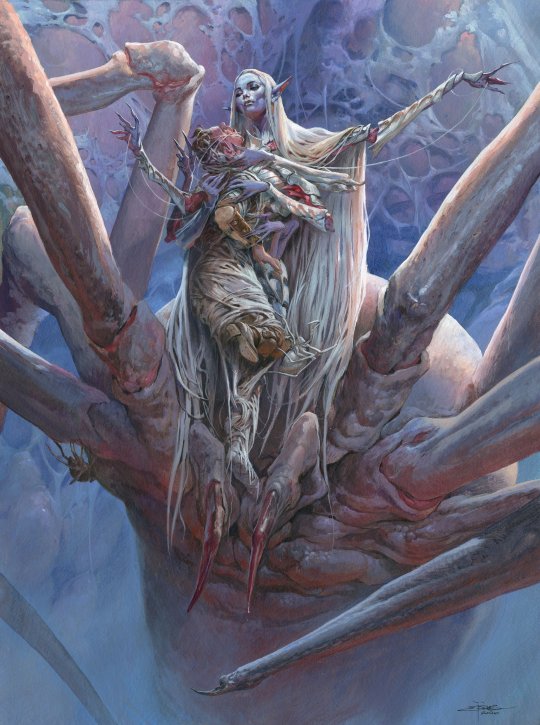
Lolth, cocooning her victim. Lolth, Spider Queen Magic: The Gathering card, "Adventures in the Forgotten Realms" expansion, 2021
Though as opposed to Slaanesh, Lolth is one of, if not the powerful demon lord since second edition, specifically 1995 "Monstrous Compendium - Planescape Appendix II", were Graz'zt (who was discussed earlier) and Demogorgon (holder of the title of the "Prince of (all) Demons" (and technically the strongest of demons), both at least to a degree, fear Lolth:
"Even a demipower such as Demogorgon or Graz’zt prefers
not to aggravate the Spider Queen needlessly, and interfering
with Lolth’s handmaidens is a quick way to draw her
attention."
There is some caveat to this, and certain Demon Lords are implied to be possibly/potentially even superior to Lolth (the Pale Night) in their full power, or if they gain (Demogorgon), or regain (Obox-Ob) their full power. And Lolth is usually not interested in ruling the Abyss, her focus more being on the Material Plane.
While Slaanesh is usually the weakest of the 4 Chaos Gods (if still more powerful than everything else), but since at least the 1997 5th Edition Warhammer Armies: Realm of Chaos, it is stated Slaanesh in time will probably become the most powerful Chaos God.
Lolth is also served by Type III Demons (later known known as Glabrezu), even having a closer connection since start.

Lolth (in drow form, in the middle) along with a Type III demon/Glabrezu (on the left) and Type II Demon/Hezrou (on the right). Q1 Queen of the Demonweb Pits, 1980
As even from the start, not only they were among her minions, in Vault of the Drow there was a Lolthite artifact, the Demon Staff, that allowed a Priestess of Lolth to transform into a Glabrezu.
Why this is is important? Well Type III demons/Glabrezu very probably were an inspiration for Warhammer's Keepers of Secrets:

Artwork of a Glabrezu/Type III demon from the original 1977 Monster Manual

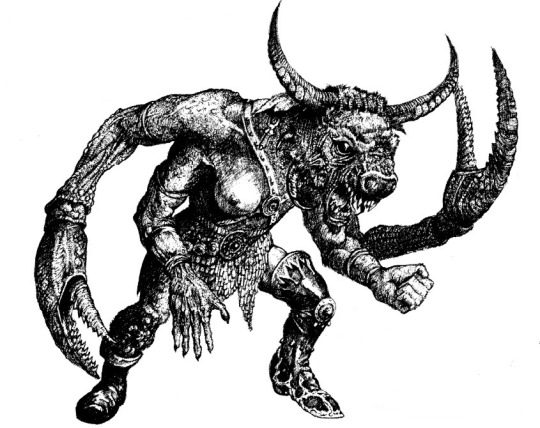
Artworks of Keepers of Secrets from "Realms of Chaos: Slaves to Darkness". This design is the closest to Glabrezu (if less canine and depending on Daemon, more goat-like or bovine), though later designs also retain a certain similarity
Glabrezu are powerful (physical and magically) and manipulative demons, that corrupt mortals. In canon compared and contrasted to succubi, who pray on lust, Glabrezu pray on desire for power in all forms of it.
Later lore curiously further connects Glabrezu and Lolth, and her worship. As first detailed in the 1990 Homeland novel by R.A. Salvatore, Drow have a ritualistic initiation orgy as form of Lolth worship - the Ceremony of Graduation/Day of Graduation (itself a further similarity between Lolth and Slaanesh worship), were the graduating students engage in sex with each other. Demons might also be summoned (and also engage in the orgy), including more often than sometimes a Glabrezu

A drow priestess summoning a Glabrezu, from the 2012 "Menzoberranzan: City of Intrigue"
In 3rd edition, it was further specified this is one of the occasions were a Draegloth (a child of a drow priestess and Glabrezu) could be conceived.

3rd edition artwork of a Draegloth from 2001 "Monster Compendium: Monsters of Faerûn"

A (male) Draegloth restraining an elf, 4th Edition Monster Manual 3, 2010
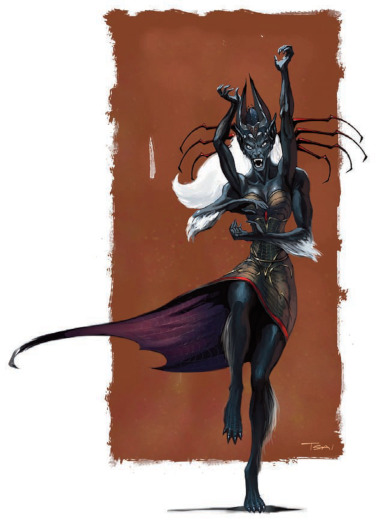
A less monstrous female Draegloth, an idea from 4th edition (originally there was not much sexual dimorphism between males and female Draegloths). Notice similarities similarities to contemporary 2006 depictions of Keepers of Secrets, as seen bellow. 2008 "Forgotten Realms Campaign Guide"

The Keper of Secrets Zarakynel, 2006 Imperial Armour Update
Another notable (even most notable) species of demons that serve Lolth, are the Yochlol, also known as "Lolth’s handmaidens".

Yochlol, fighting adventures, in both their "true" amorphous, eight-tentacled form (left) and giant spider form (right). Q1 Queen of of the Demonweb Pits, 1980
Yochlol are notable as having several forms - the two seen on the illustration (amorphous and giant spider), gaseous one, and of a female humanoid form (almost always of a highly attractive drow, other elven form, or human form) that can be changed. In their first appearance in 1980 Queen of the Demon Web Pits, they used their form as beautiful women in silken gowns, to try to fool and manipulate the player characters.
1991 "Drow of the Underdark" expands quite a lot about them. It reveals they can near perfectly hide their alignment (morality) (even from alignment detecting spells), and that they are fully devoted to Lolth, as opposed to more mercenary nature of most demons in D&D. They are also described there as being able to seduce mortals very well, but also stated to often actually love their mortal lovers (if rather selfishly), and avenge them if they are killed.
The Yochlols origin is fully described/revealed in 2006's "Fiendish Codex I: The Hordes of the Abyss", stating Lolth created the first Yochlol by severely modifying succubi, essentially making them a succubi species, if one fully loyal to Lolth, with different abilities. Lolth though most commonly now creates new Yochlol from souls of her deceased priestesses, or by transforming weaker demons. As well still having normal succubi serving her.

Yochlol, shifting between it's amorphous and drow forms. "Demon Queen's Enclave", 2008
There were some hints of it before - their abilities and tactics being similar to a succubus' in D&D, or succubi-like. In first edition, the Yochlol's gaseous form, being a equivalent of the succubus' ethereal form, Domination of Succubus' Charm Person. The above mentioned "Monstrous Compendium - Planescape Appendix II", expanded on Yochlol tactics and abilities, stating that Yochlol often first "uses its beauty and charm to beguile its opponents". It also gave the Yochlol a Charm Person ability along Domination, as well as an interesting psionic ability - "Attraction" - that "creates an overwhelming attraction to a particular person or thing - be it an item, creature, action, or event".
4th Edition's Monster Manual II from 2009, also gave Yochlol the "Seductive Glare", ability that can Charm an opponent, further exploring the similarity between Succubi and them.
Again, this is a one heck of a long post. To think I originally wanted to make this and the post about Graz'zt one ^^;
I also considered posting first the possible inspirations for Tzeentch by Fraz-Urb'luu and Pazuzu, but this one was already partially finished.
[EDIT]
Corrected some mistakes, and expanded on two subjects (another official in-universe spelling/form of Lolth's name that could inspire Slaanesh' names and on Yochlol).
#slaanesh#lolth#lloth#dungeons & dragons#advanced dungeons & dragons#dnd#inspiration#warhammer fantasy#warhammer#40k
38 notes
·
View notes
Text

Priestesses would honor the Spider Queen by conducting rituals, leading sacrifices, and spreading the faith. Sacrifices of surface elves would occur monthly, usually during a full moon as a direct insult to the elven deity Sehanine Moonbow.
4 notes
·
View notes
Text


🕷The drowification continues🕷

#drow#drow lore#drowelf#dnd drow elf#drow elf#dnd drow#Eilistraee#Lolth#Lloth#Lolth the spider queen#Lloth the spider queen#drizzt#drizzt do'urden#Xorlarrin#dungeons and dragons
3 notes
·
View notes
Text
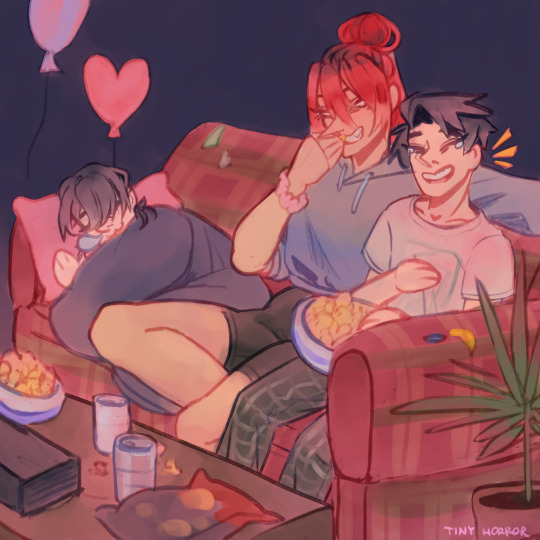
bday 2023. they are watching wwdits movie
insta | twitter | inprnt | redbubble
#my art#csp#clip studio paint#digital artist#digital art#small artist#own art#original art#oc#lloth#???#mei#mort oc#my oc#queer oc#queer artist#ukrainian artist#украрт#український tumblr#укртумбочка#sapphic oc
7 notes
·
View notes
Text
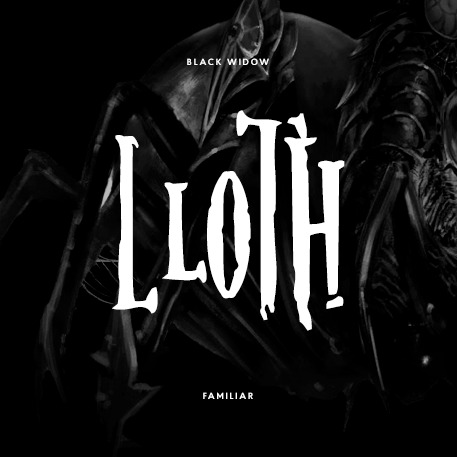





ㅤ ㅤ ㅤ
ㅤ ㅤ ㅤ⠇𝐇𝐈𝐆𝐇 𝐏𝐑𝐈𝐄𝐒𝐓𝐄𝐒𝐒 𝐃𝐑𝐎𝐖
A familiar in the form of a huge, venomous spider named Lolth, who, at the first word of the mistress executes any orders given; is able to turn into a priestess, a female drow, with dark skin, white hair and scarlet eyes.
ㅤ ㅤ ㅤ
0 notes
Text
Do you know what I really really want more of in bg3? Drow politics. You’re telling me Minthara dipped out of the strongest house of Drow there is, Lloths favorite if you will, and there are no repercussions for that?
#haunted one speaks#bg3#baldur's gate 3#drow#look#let me get hunted by Lloth sworn drow for taking in a refugee#good or bad run#like Lloth don’t fucking play
27 notes
·
View notes